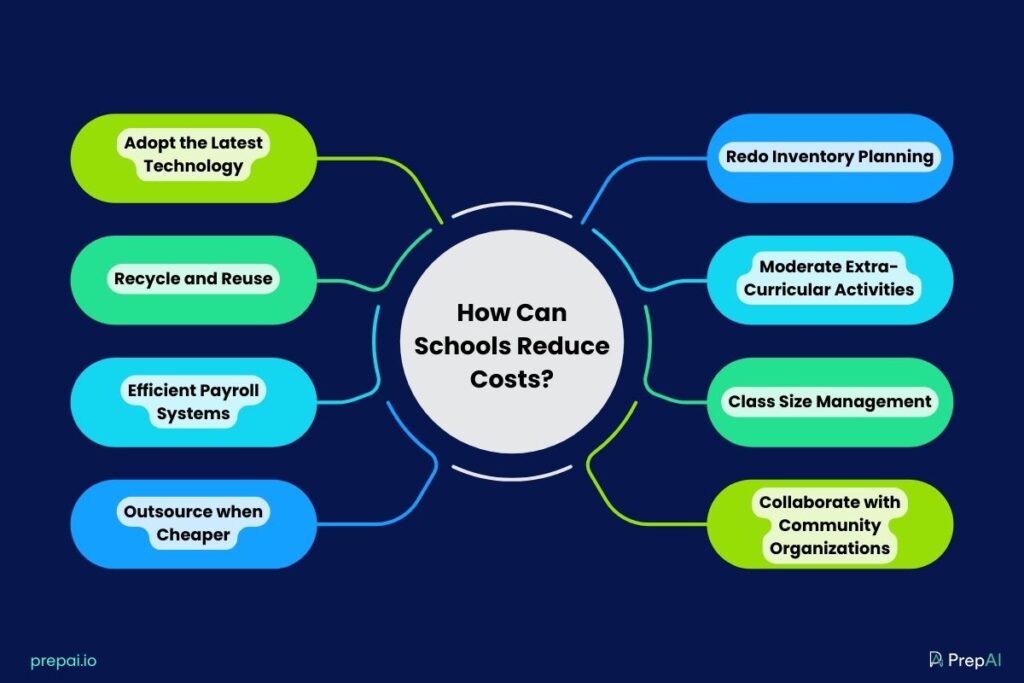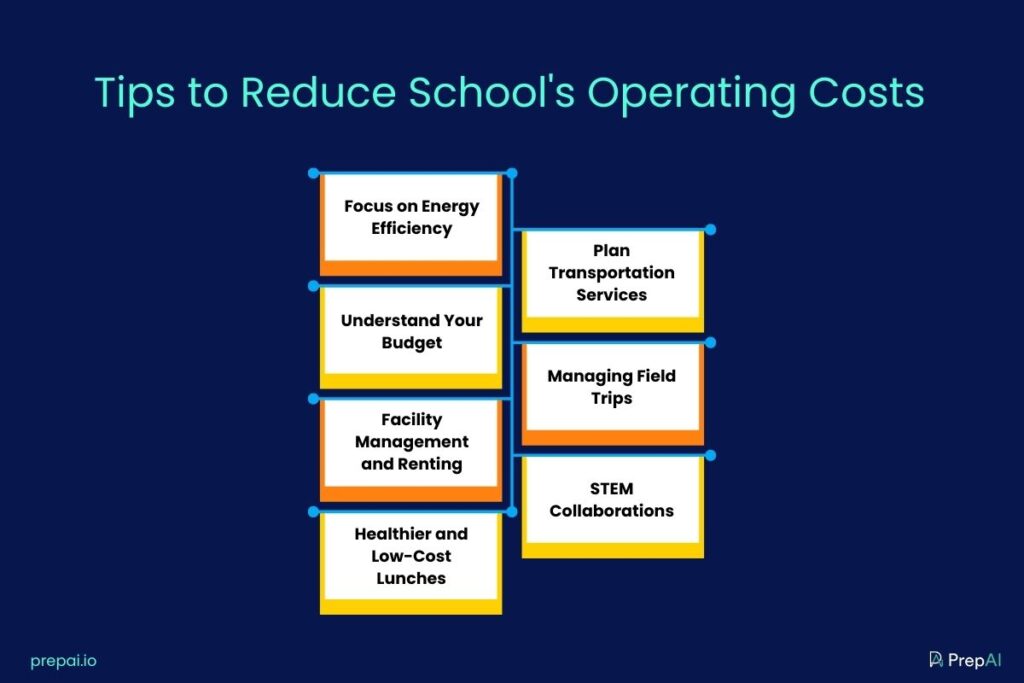Increasing expenses push schools into losses and difficult situations. With proper planning and a systematic approach, schools can reduce costs while adopting the latest technology. Let’s discuss the different ways an educational institution can cut down expenses.
The Covid-19 pandemic and the subsequent inflation have affected most lives around the globe. Just about everything has been disrupted and had to be restarted to align with the new normal. Schools and educational institutions too suffered from losses.
The changing scenario demands the school administrations step up and deal with the issues effectively or shut shop forever. Closing schools is never a good sign for society. The administrations must make the right decisions to cut costs without compromising the quality of education and services they provide to students.
Schools also need to focus on retaining experienced and efficient teachers to handle the responsibility of training students for the future. Let’s look at the various ways for schools and colleges to reduce expenses.
How Can Schools Reduce Costs?
Schools can adopt several strategies to reduce costs effectively while maintaining or even improving educational outcomes. Here are some key approaches based on recent studies:

1. Adopt the Latest Technology
While the initial investment in technology may seem high, adopting the right tools and software can lead to long-term savings. For instance, going paperless by using digital textbooks and online resources reduces the need for physical materials, such as paper, printers, and ink. Additionally, adopting tools like education management software can automate processes like sending emails, collecting fees, and scheduling classes, further reducing overhead costs.
Go Paperless:
Moving student and teacher records to the cloud eliminates the costs associated with maintaining physical files.
Automation:
Using software to handle administrative tasks streamlines operations, allowing schools to optimize their resources.
AI-Powered Tools:
Tools like PrepAI automate the creation of exam papers, saving teachers time and allowing them to focus on completing the syllabus.
eLibrary:
Building a digital library for students and teachers reduces the costs of maintaining physical books while offering 24/7 access to educational resources.
2. Recycle and Reuse
Schools generate substantial waste, but by recycling and reusing materials, they can reduce their environmental impact and save money on supplies. For instance, schools can recycle plastic bottles in exchange for coupons or sell metal as scrap, thus turning waste into a financial advantage.
3. Efficient Payroll Systems
Salaries for teachers and administrative staff account for a significant portion of school budgets. Streamlining the payroll system with software that tracks working hours, overtime, and holidays can reduce administrative costs and free up resources without compromising educational quality. This approach improves efficiency and helps schools manage staffing costs effectively.
4. Outsource When Cheaper
Instead of hiring full-time employees for every task, schools can outsource specific services, such as IT support, maintenance, or cafeteria operations, when it’s more cost-effective. Outsourcing can reduce the need for long-term contracts and provide flexibility in managing resources.
5. Redo Inventory Planning
Schools often overspend on supplies, such as stationery, books, and uniforms, that may not be fully utilized. By regularly reviewing inventory and purchasing only what’s necessary, schools can prevent wastage and save money. Education management software can assist in tracking inventory and distributing it more efficiently across classrooms.
6. Moderate Extra-Curricular Activities
While extracurricular activities are essential, not all may be necessary or cost-effective. Schools can reduce costs by offering only those activities that directly contribute to students’ education and personal growth. Activities like role-playing can even be incorporated into regular classroom sessions to make learning more interactive without requiring additional resources.
7. Class Size Management
Reducing the number of sections or increasing the class size slightly can help lower staffing and operational costs. A balanced class size allows for effective teaching while reducing the need for additional resources. By adding a few more students to each section, schools can optimize their teacher-to-student ratios and allocate time more efficiently.
8. Collaborate with Community Organizations
Schools can also collaborate with local community organizations to share resources, such as facilities or personnel. This reduces duplication of efforts and allows schools to benefit from the shared services without increasing costs.
7 Tips to Reduce School’s Operating Costs
Operating costs pile high even before you know it. Most schools, colleges, and educational institutions face this issue. With cautious planning, it is possible to reduce operational costs without affecting the reputation of an institution.

1. Focus on Energy Efficiency
Becoming energy-efficient can cut costs and inspire students to become eco-conscious by setting an example. Here’s how schools can save on energy charges and optimize their energy usage.
Get rid of old electric equipment as it requires more energy and increases your bills. Invest in certified energy-efficient appliances and gadgets. Start with the fans and bulbs in the classrooms.
Depending on your country/ region, you can get benefits and subsidies for installing solar panels at school and using alternate sources of energy.
Set timers to turn off lights, fans, ACs, etc., and reduce the thermostat to the lower point when there’s no school.
2. Understand Your Budget
What are the income sources for the school? Before making any major changes or employing cost-cutting measures, it is essential to take stock of the overall situation. Your decision shouldn’t indirectly affect your income as it can lead to chaos and losses.
Taking funds or donations for granted can also cause trouble if the expected money doesn’t come on time. Relying solely on students’ fees is also not advised. Once you have a clear picture of the income sources, you can cut down on unnecessary expenses.
3. Facility Management and Renting
Do you own the school premises? If yes, paying is rent one less thing to worry about. However, maintenance costs are a cause of concern. As the buildings get older, you have to spend more money on repairs and maintenance to adhere to the safety regulations.
In such instances, renting a portion of the premises or unused buildings can bring extra income. Summer holidays are a good time to rent the open areas, classrooms, and other buildings. You can even rent the community hall during weekends.
4. Healthier and Low-Cost Lunches
Healthier lunches are more important for kids than multiple choices of fast foods. Schools can cut down costs on lunches while still providing healthy meals to students. Tie up with organizations that provide nutritious meals for a lesser cost. This also promotes healthy eating in students and reduces the risk of obesity.
5. Plan Transportation Services
Does the school offer paid transportation services to students? Consider the options to see if outsourcing transportation would be a cost-effective solution. School management can also discontinue transportation and leave the responsibility to the parents and guardians.
6. Managing Field Trips
Field trips are important for students to see things for themselves. Nowadays, you can provide a similar experience in the classrooms through AR/ VR technology. Another way to cut costs is to map the budget of the trip in advance and ask for volunteers to help with transportation and lunch rather than spend on hiring drivers or paying restaurant bills. Maybe the authorities of the place you are planning to visit can help. Find ways to plan the trips without being extravagant.
7. STEM Collaborations
As STEM education is becoming a part of every school and college, the costs to establish and manage the STEM department has gone up. This expense can be reduced by collaborating with nearby colleges or institutions that offer STEM teaching/ coaching services. Renting the facilities and staff for a fixed number of classes per term will save money compared to setting up the entire faculty on the campus.
Final Words
Reducing costs at school doesn’t have to put you out of competition. By carefully deciding what works and what doesn’t, school administration can cut down the expenses and remove the burdens that are stopping them from adopting advanced technology.
Whether it is an artificial intelligence tool like PrepAI, payroll management system, or curriculum creator software, it’s imperative to choose the right solution for the school. Consult with technology solution providers to help you decide the right approach to cost-cutting and school management.



